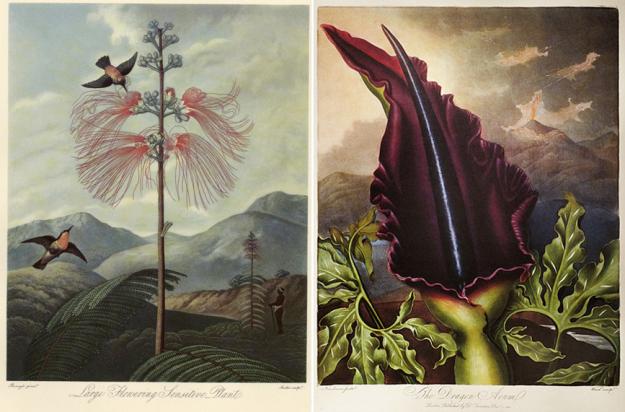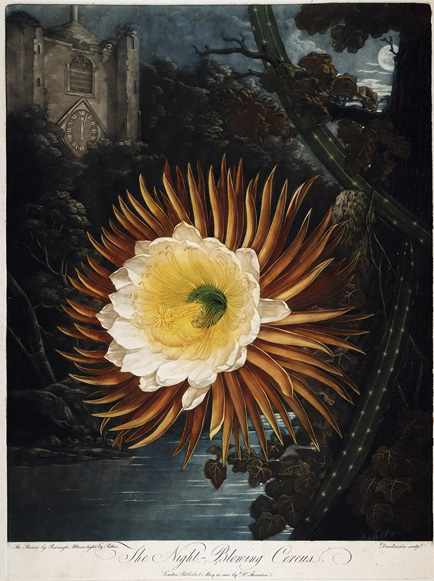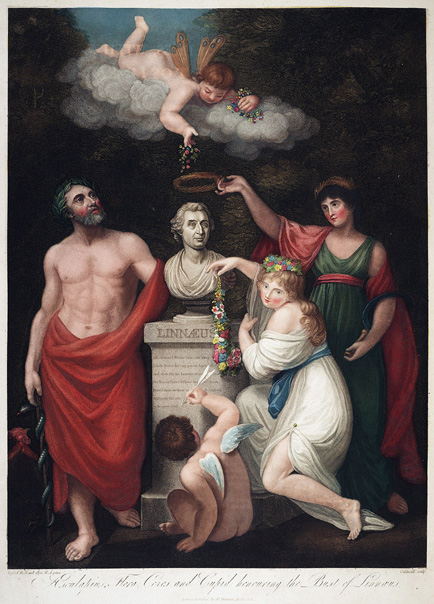
PHOTO BY: Large Flowering Sensitive Plant (Mimosa grandiflora), Dragon Arum (Dracunculus vulgaris); Temple of Flora, Robert John Thornton
"The object of this work is to trace in as perspicacious a manner as possible the philosophical principles of botany, from the earliest times, up to the present period, and by faithful and well executed engravings of the several subjects of the investigation, to render this curious and interesting inquiry level to everyone's comprehension."—Robert John Thornton
In 1797, an influential physician, wealthy heir, and botanic enthusiast named Dr. Robert John Thornton (1768-1837) undertook the tremendous task of producing a flower book that would establish Britain as the preeminent publisher of artistic and scientific works. An exploration into the "philosophical principles of botany," the florilegium (book of flowers) would dazzle royal subscribers with patriotic allegories, and daunt contemporary French illustrators with exquisite full-color plates. In homage to the great Swedish naturalist, it was titled The New Illustration of the Sexual System of Linnaeus. While its ambitious publication—largely self-funded, hugely expensive, and unsurpassed in grandeur of the period—would fall short of its initial prospectus, and ultimately leave its author in financial ruins, it would also be celebrated as one of the most spectacular works of botanic literature and illustration ever produced.

A Group of Tulips. Plate 25. Published on May 1st, 1798, this was the first print of the book. Note the windmill in the background of the romantic Dutch landscape.
The last, and most famous, of the book's three volumes was The Temple of Flora (1799-1807), a folio of thirty-two botanical portraits (the entire work can be downloaded here, courtesy of the Missouri Botanical Garden's archive). Thornton commissioned a host of English masters to paint and engrave the intaglio plates, which were a combination of mezzotint, aquatint, line and stipple engraving, finished with watercolor. The plants were curated as a selection of the most exotic species that were arriving on Britain's shores from all corners of the globe.
Unlike his contemporaries, who tended to illustrate botanic specimens on austere plain backgrounds, Thornton staged his plants in dramatic landscapes that carried the grandiose gestalt of the book, if not its scientific accuracy. These habitats were ostensibly not incorrect, though charming creative liberties were occasionally taken. For example, Thornton writes of the cereus flower (Selenicerus grandiflorus), "Each scenery is appropriated to the subject. Thus in the night-blooming Cereus you have the moon playing on the dimpled water, and the turret-clock points XII, the hour at night when this flower is in its full expanse." While it is true that the cereus does open after sunset, an English churchyard is an unlikely natural habitat, but one that creates a lovely sense of place. It's a wonderfully grand approach to a florilegium, and one for which Thornton can hardly be faulted, if we regard the book as less a scientific reference, and more a magnificent work in the canon of eighteenth-century Romanticism, when there was not a hard divide between art and science.

Night-blooming Cereus (Selenicerus grandiflorus). Plate 29.
The commentary, written by Thornton, is no less extraordinary. The reader's journey through lavish and exotic landscapes is narrated by exuberant swathes of text that meander among science, religion, mythology, and politics. Some of Thornton's "Explanations" (as he calls them) are written as traditional descriptions of the floral species, while others are poetic allegories of British nationalism. Thornton writes of the rose: "Nature has given her a vest of purest white, and also imperial robes of the brightest scarlet; and that no rude hand should tear her from her rich domain, she is protected by a myriad of soldiers, who present on every side their naked and sharp swords against the daring invader." England is personified as the rose, and Napoleon Bonaparte as the "daring invader." And the blue Egyptian water lily, painted into a hazy dawn over the Nile River, is accompanied by an account of British Admiral Sir Horatio Nelson's victory in the Battle of the Nile, with a list of defeated French ships. Thornton was less concerned with each plant as a scientific specimen, and more interested in what the plants meant to Britain.

Blue Egyptian Water-Lilly (Nymphaea Coerulea). Plate 46.
The Temple of Flora is perhaps the most famous florilegium from the golden age of botanical illustration: a charming collection of deliberately idiosyncratic flower portraits that became the portrait of a nation. Lack of funding prevented the book from being published in full during Thornton's life and it wasn't until 2008 that a full-size and complete fascimile was produced, by the Folio Society. The production details would have certainly pleased Thornton: The book is quarter-bound in Nigerian goatskin with cloth sides, has 232 pages with nine preliminary monochrome plates, five preliminary color plates, and 29 flower illustrations, measuring 22½" x 18¼" and weighing a hefty 28 pounds.

Aesculapius, Ceres, Flora, and Cupid, Honouring the Bust of Linnaeus. Plate 17.






















कोई टिप्पणी नहीं:
एक टिप्पणी भेजें